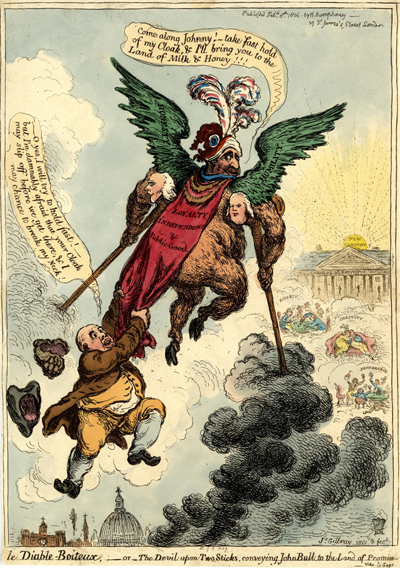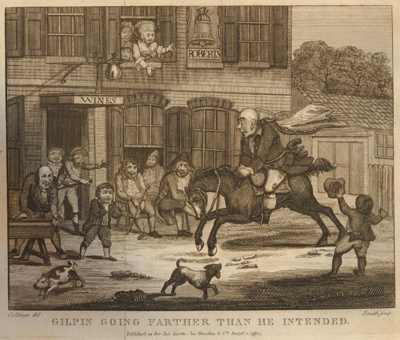Le Diable-Boiteux, or the Devil upon Two Sticks. . .
Like other prints signed as "invt & fect" where Gillray takes credit for both the idea and execution, Le Diable-Boiteux is highly allusive and sometimes intentionally ambiguous, inviting us to see the print from a number of different perspectives.
The first and most obvious allusion is to the satiric French novel, Le Diable-Boiteux by Alain Rene Le Sage first published in 1707, and translated a year later as Le Diable-Boiteux, or The Devil upon Two Sticks. In Le Sage's novel, a lame devil by the name of Asmodeus is released from his imprisonment inside a magician's bottle by a student, Don Cleophas who had climbed through the window into the magician's attic while fleeing for his life from "three or four hired assassins." Knowing that neither of them was safe in the attic, Asmodeus tells the student to hold on to the end of his cloak and whisks him into the air above the city, where his powers as a devil allow him to look down and peer into the secret lives of its inhabitants.

© Trustees of the British Museum
In Le Sage's novel, however, the Devil is primarily a satiric vehicle, a witty guide who can expose the corruption seen in a sequence of episodes. That's why the narrative framemwork was able to be used by later Englishmen such as Samuel Foote who in 1768 produced a comedy in three acts The Devil upon Two Sticks with Mr. Foote in the role of the lame devil. And why in 1790, William Combe was able to publish The Devil upon Two Sticks in England, A Continuation which easily adapted the satire to another time and place.
For Gillray, the focus was different. The story's primary appeal was that it provided yet another opportunity to identify Charles James Fox as a devil and to describe his current political situation using details from the story. In keeping with Le Sage, Fox is shown with devil/satyr-like haunches and a cloven foot. But he has the familiar bonnet rouge of a French revolutionary and a set of three plumes which also associate him with Fox's long-time friend, the Prince of Wales. His crutches, or "sticks" include caricatures of William Grenville and Henry Addington (recently become Vicount Sidmouth) who supported Fox's inclusion in the Ministry of All Talents which had just been formed in the wake of William Pitt's death on January 23. In identifying the two sticks as literal supporters, however, Gillray may be borrrowing an idea from a satiric print called The Devil upon Two Sticks featuring Sir Robert Walpole (as the devil) being carried over a filthy pond by two members of Parliament.
In Le Sage's novel, the student, Don Cleophas, is launched into the air holding fast to the Devil's cloak. In Gillray's print, that role is assumed by John Bull, the proto-typical Englishman, who (like Gillray) is highly suspicious of Fox's promises and objectives. With wings labeled "Honesty" and "Humility" and a cloak proclaiming "Loyalty, Independence, & Public Good," Fox claims to be carrying "Johnny" to a "Land of Milk and Honey." But what we can see is that Fox's direction is towards the sun of a new "New Constitution" shining over Carlton House, the residence of the Prince of Wales. The values of the Prince are shown in the three scenes portrayed in front of Carlton House where "Liberty" is the freedom to gamble; "Chastity" is the secret and illicit marriage to the Catholic Mrs. Fitzherbert; and "Temperance" is another drunken midnight modern conversation.
Carlton House is conspicuously labeled "Carolus II Redivivus" (Charles II Brought Back to Life). Taken with the scenes just mentioned this label may suggest a revival of the debauchery of Charles's Restoration court at Carlton House and perhaps a pro-Catholic stance. But it may also suggest the revival of another Charles—Charles James Fox— who after years in the Opposition is now receiving a second chance to govern.
Not surprisingly, with Fox's tri-color plumes proclaiming an alignment with France and the Prince of Wales, and his record of making self-serving political choices, Fox's promises of loyalty (to the King) and dedication to the "Public Good" are greeted with skepticism by John Bull.
O yes, I will try to hold fast!_ but I'm damnably afraid that your Cloak may slip off before we get there, & I may chance to break my Neck!
The British museum commentary correctly notices the similarity of John Bull in this instance to another famous "Johnny" whose runaway horse takes him for a wild ride in which he ends up miles away from his intended destination, losing his hat and wig in the process. Gillray's allusion is to The Diverting History of John Gilpin, a ballad by William Cowper first published in 1782, and the resulting print, Gilpin Going Farther Than He Intended (1784) by Samuel Collings. The poem was exceedingly popular, and the basis of numerous toys and books.

Gilpin Going Farther Than He Intended
[August 1, 1784]
© Trustees of the British Museum
As it turned out, Gillray was wrong on almost every count. The new administration with Fox as Foreign Secretary was no more friendly to France than Pitt's. It showed no shift away from the King and towards the Prince of Wales, and in fact, the wild ride Gillray anticipated never materialized.
Sources and Reading
- Commentary from the British Museum on Le Diable-Boiteux.
- Draper Hill, Mr. Gillray The Caricaturist, 1965, p. 121.
- "Henry Addington," Wikipedia
- "Charles James Fox," Wikipedia
- "George IV," Wikipedia
- "William Grenville, 1st Baron Grenville," Wikipedia
- "Ministry of All the Talents," Wikipedia
- "Alain-René Lesage," Wikipedia
- The Diverting History of John Gilpin
- Thomas Wright and R.H. Evans, Historical and Descriptive Account of the Caricatures of James Gillray #307.
- Thomas Wright and Joseph Grego, The Works of James Gillray, the Caricaturist; With the History of His Life and Times, p. 328.
Comments & Corrections
NOTE: Comments and/or corrections are always appreciated. To make that easier, I have included a form below that you can use. I promise never to share any of the info provided without your express permission.